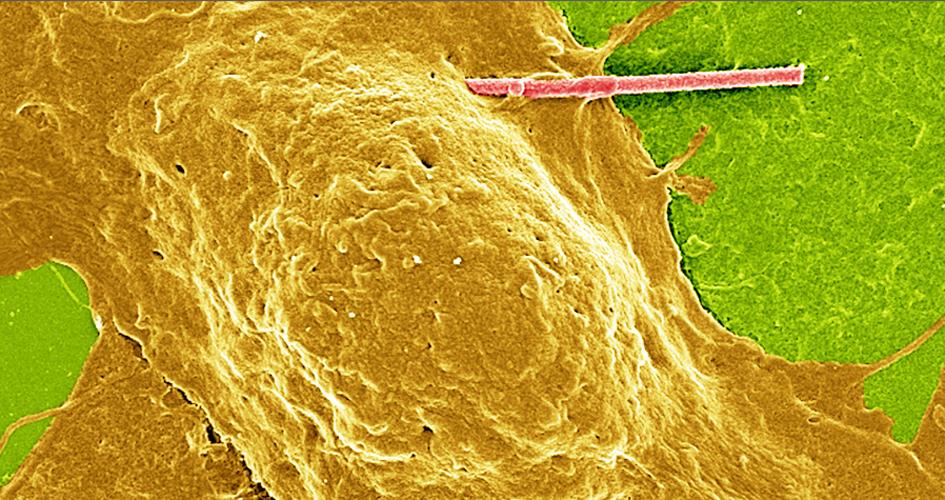March 5, 2018
Could wires help re-wire brain’s neuronal circuits? A new technique to modulate neuronal conductivity developed in the Tian lab, UChicago
Congratulations to the Tian lab, UChicago, for a new publication in Nature Nanotechnology, that describes how tiny nanowires positioned in close proximity can influence the electrical activity of cultured neurons. Built of gold-coated silicon, the nanowires produce tiny electrical currents upon activation with light, lowering the threshold for the action potential and triggering the neurons to fire. The authors hope that this innovative technique may help study neuronal and brain activity, and with time even have therapeutic potential. Senior author on the paper, Bozhi Tian, UChicago, is a past CBC Postdoctoral Research Award (2014) recipient. A co-author on the paper, John Zimmerman, was a graduate student at the Tian lab (now at Harvard) and a CBC Scholar, class of 2014.
Researchers invent tiny, light-powered wires to modulate brain’s electrical signals
UChicago News | by Louise Lerner | February 19, 2018

The rod at top right is positioned to modify electrical signaling between the neurons. The entire image is smaller than the diameter of a single human hair. Courtesy of Parameswaran, et al.
The human brain largely remains a black box: How the network of fast-moving electrical signals turns into thought, movement and disease remains poorly understood. But it is electrical, so it can be hacked—the question is finding a precise, easy way to manipulate electrical signaling between neurons.
A new University of Chicago study shows how tiny, light-powered wires could be fashioned out of silicon to provide these electrical signals. Published Feb. 19 in Nature Nanotechnology, the study offers a new avenue to shed light on—and perhaps someday treat—brain disorders.
Ten years ago, the science world was alive with speculation about a recently discovered technique called optogenetics, which would manipulate neural activity with light. The problem is that it has to be done with genetics: inserting a gene into a target cell that would make it respond to light. Other ways of modulating neurons have since been suggested, but a perfect alternative remains elusive.
A team led by Asst. Prof. Bozhi Tian built minuscule wires previously designed for solar cells. These nanowires are so small that hundreds of them could sit side by side on the edge of a sheet of paper—putting them on the same scale as the parts of cells they’re trying to communicate with.
These nanowires combine two types of silicon to create a small electrical current when struck by light. Gold, diffused by a special process onto the surface of the wire, acts as a catalyst to promote electrochemical reactions.
“When the wire is in place and illuminated, the voltage difference between the inside and outside of the cell is slightly reduced. This lowers the barrier for the neuron to fire an electrical signal to its neighboring cells,” Tian said.
The team tested the approach with rat neurons grown in a lab, and saw they could indeed trigger neurons to fire these electrical signals.

John Zimmerman, PhD
John, a co-author on the publication, was a graduate student at the Tian lab (now at Harvard) and a CBC Scholar, class of 2014
“The nice thing about it is that both gold and silicon are biologically compatible materials,” said graduate student Ramya Parameswaran, the first author on the study. “Also, after they’re injected into the body, structures of this size would degrade naturally within a couple of months.”
“It’s a fundamental but very promising approach,” Tian said. They plan next to test the system in animals, which could both help researchers further understand how these electrical signals work in the brain as well as suggest ways to address problems like Parkinson’s disease or psychiatric disorders.
The other co-authors were Francisco Bezanilla, the Lillian Eichelberger Cannon Professor of Biochemistry and Molecular Biology; Erin Adams, the Joseph Regenstein Professor of Biochemistry and Molecular Biology; graduate students John Zimmerman (now at Harvard), Kelliann Koehler, Yuanwen Jiang and Andrew Phillips; postdoctoral researchers Jaeseok Yi and João Carvalho-de-Souza; and undergraduate student Michael Burke.
Funding: Air Force Office of Scientific Research, National Science Foundation, National Institutes of Health, Searle Scholars Foundation, Paul and Daisy Soros Foundation, Alfred P. Sloan Foundation.
Source:
Adapted (with modifications) from UChicago News, by Louise Lerner, posted on February 19, 2018.
*Publication attributed to CBC funding:
Parameswaran R, Carvalho-de-Souza JL, Jiang Y, Burke MJ, Zimmerman JF, Koehler K, Phillips AW, Yi J, Adams EJ, Bezanilla F, Tian B. Photoelectrochemical modulation of neuronal activity with free-standing coaxial silicon nanowires. Nat Nanotechnol. 2018 Feb 19. [Epub ahead of print] (PubMed)
Ties to CBC:
*CBC Scholar Award:
John Zimmerman, graduate student in the Tian lab (UChicago; now at Harvard)
▸ CBC Scholar: Class of 2014
CBC Postdoctoral Research Award (2014):
Yucai Wang and Bozhi Tian (UChicago) for the project:
▸ A Synthetic Biomineral Integrated with Silicon Nanowires

